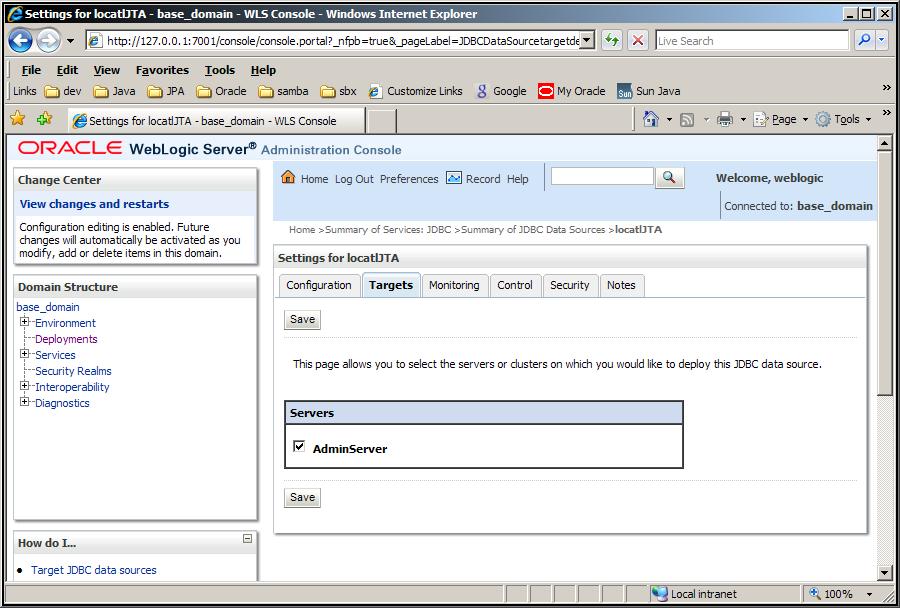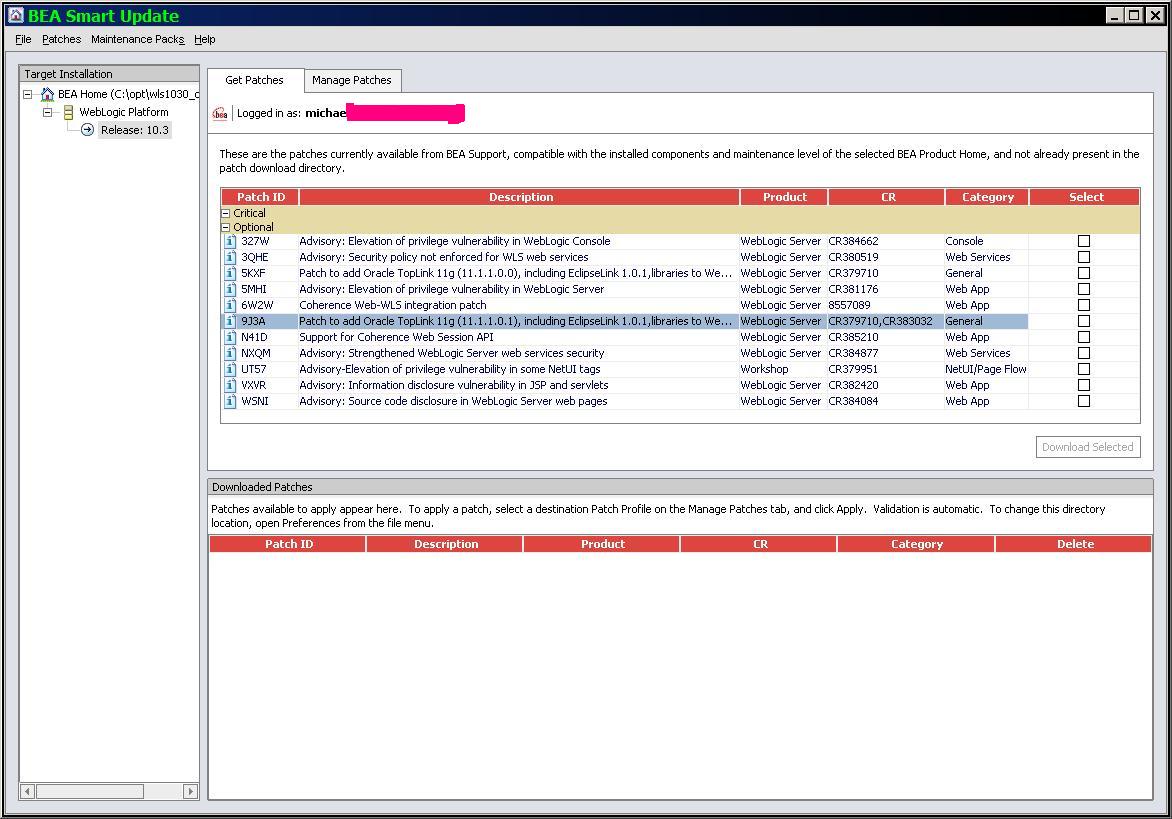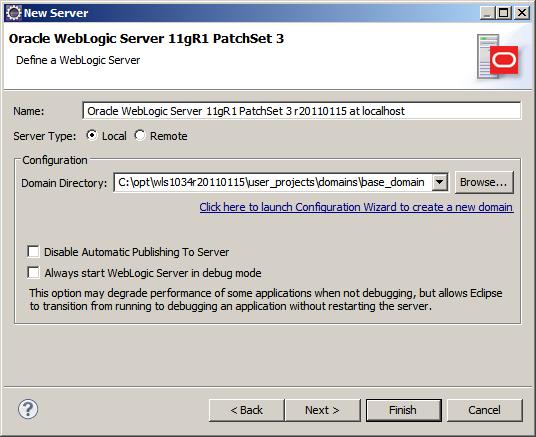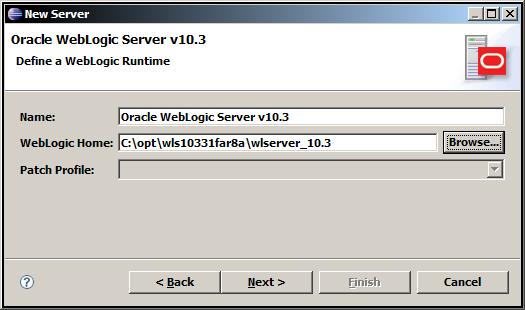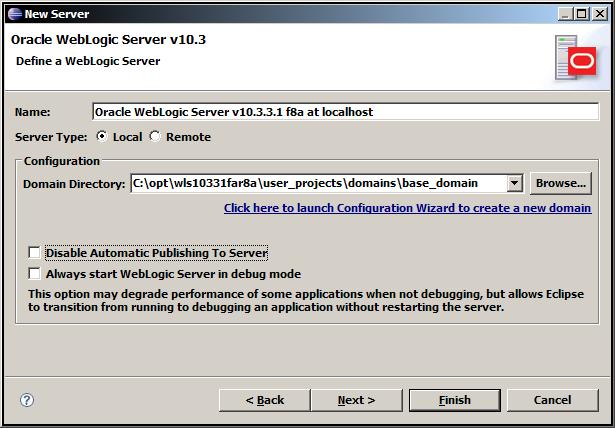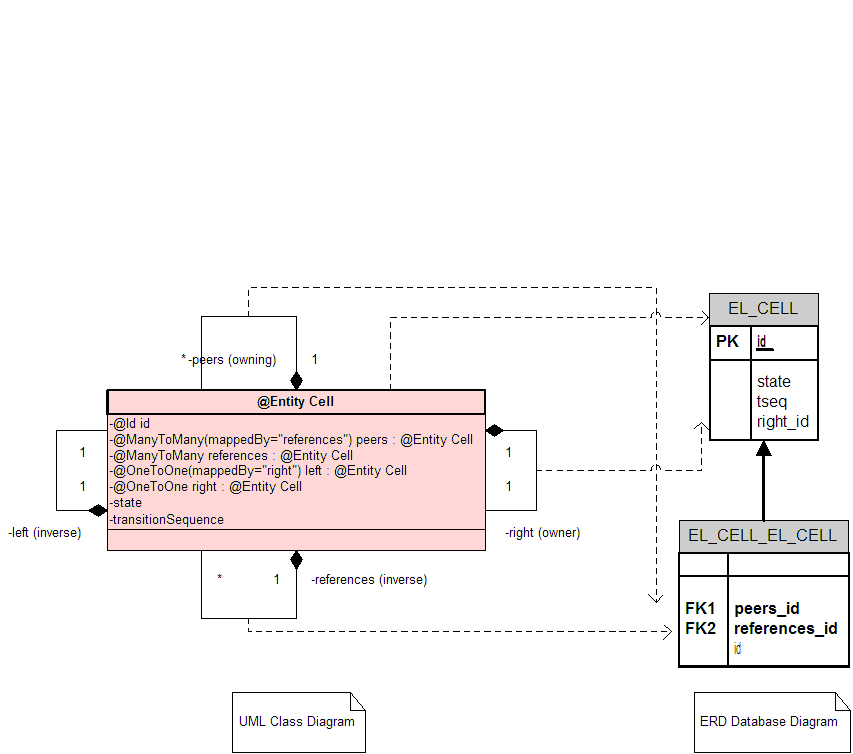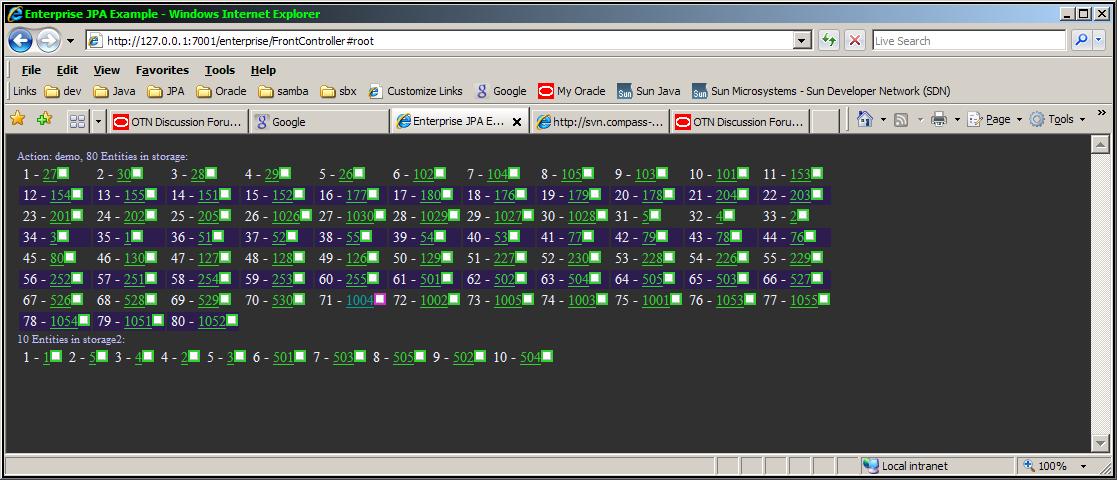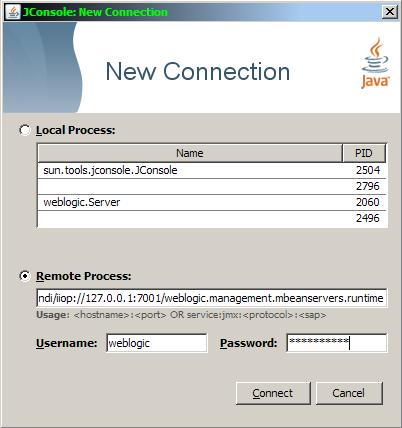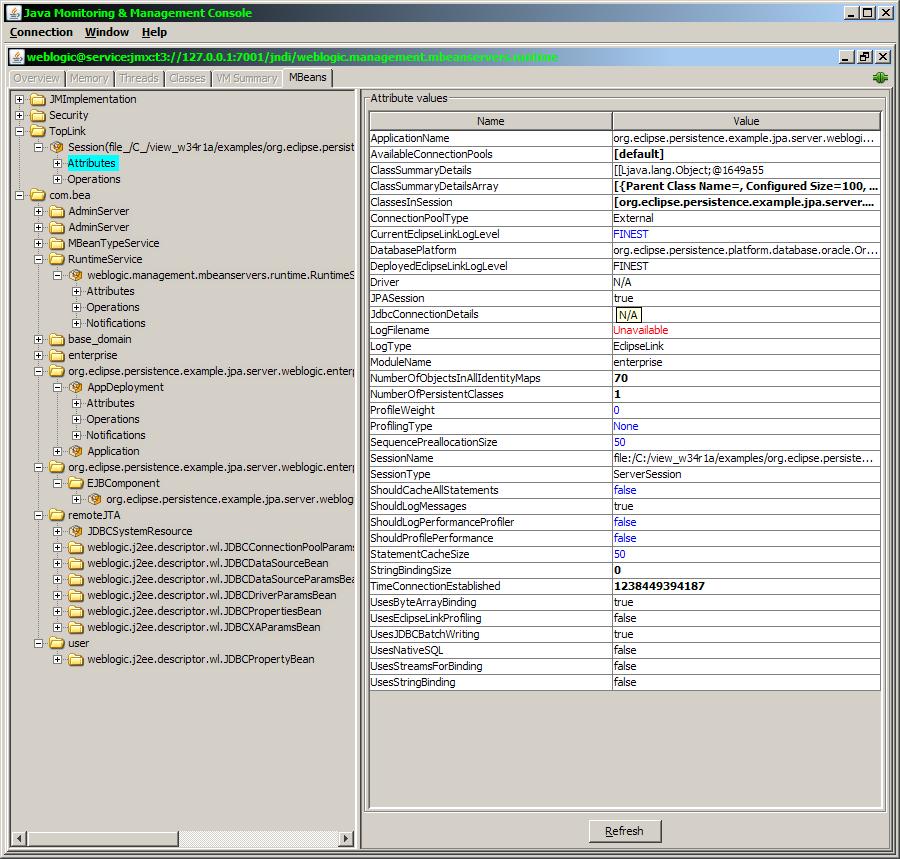Notice: this Wiki will be going read only early in 2024 and edits will no longer be possible. Please see: https://gitlab.eclipse.org/eclipsefdn/helpdesk/-/wikis/Wiki-shutdown-plan for the plan.
Difference between revisions of "EclipseLink/Examples/JPA/WebLogic Web Tutorial"
m (→Option 1: Leave shipped module as is - Recommended) |
m (→Option 1: Leave shipped module as is - Recommended) |
||
| Line 150: | Line 150: | ||
**Why? One reason is that an application deployed EclipseLink jar will be lower on the server ClassLoader tree and will not be available to other modules or applications higher up due to hierarchical visibility constraints. However, there may be occasions during '''development''' or '''staging''' that you will want to run a local copy or different version than the one loaded from the modules directory - I have not tested this scenario yet, a test of the 3 use cases will be required. | **Why? One reason is that an application deployed EclipseLink jar will be lower on the server ClassLoader tree and will not be available to other modules or applications higher up due to hierarchical visibility constraints. However, there may be occasions during '''development''' or '''staging''' that you will want to run a local copy or different version than the one loaded from the modules directory - I have not tested this scenario yet, a test of the 3 use cases will be required. | ||
| − | ===Option 1: | + | ===Option 1: Apply Smart Update Patch - Recommended=== |
====Oracle WebLogic 10.3.0.0 Standalone Server==== | ====Oracle WebLogic 10.3.0.0 Standalone Server==== | ||
=====Commercial TopLink Customers===== | =====Commercial TopLink Customers===== | ||
Revision as of 14:20, 15 June 2009
Contents
- 1 EclipseLink JPA Deployed on Oracle WebLogic using Eclipse WTP
- 1.1 Tutorial Source
- 1.2 Development Environment
- 1.3 Prerequisites
- 1.4 WebLogic configuration Changes
- 1.5 JNDI Datasource Setup
- 1.6 EclipseLink JAR location
- 1.7 JDBC JAR location
- 1.8 Create server in Eclipse
- 1.9 Create J2EE application
- 1.10 Persistence.xml
- 1.11 Start Server
- 1.12 Publish EAR
- 1.13 Perform a JPQL query
- 1.14 Troubleshooting
- 1.15 EJB bean JNDI client lookup without injection
- 1.16 JMX MBeans
- 1.17 References
- 1.18 Oracle WebLogic Server Documentation Links
EclipseLink JPA Deployed on Oracle WebLogic using Eclipse WTP
If you want to get a small JPA / EJB 3 based web application running quickly on WebLogic - the services provided by the Web Tools Project plugin in the Eclipse IDE can take care of the deployment details and set the server into debug mode for you.
This basic example details how to use Eclipse to run/debug a minimum J2EE web application servlet using EclipseLink JPA as the persistence provider. The goal of this example is to detail the minimum steps needed to run EclipseLink inside WebLogic using the Eclipse IDE - at this point no presentation/controller layer such as JSF, Spring or Struts will be used beyond a basic HttpServlet so we can concentrate on the the integration layer JPA setup.
Tutorial Source
The EAR, EJB and WEB Eclipse project source for this EclipseLink WebLogic tutorial is available online at the following locations. These 3 projects must be imported along with the jpa core eclipselink project.
- Checkout the following 3 projects together from $trunk/examples.
- org.eclipse.persistence.example.jpa.server.weblogic.enterpriseEAR
- org.eclipse.persistence.example.jpa.server.weblogic.enterpriseEJB
- org.eclipse.persistence.example.jpa.server.weblogic.enterpriseWeb
- EclipseLink source via SVN committer access
svn+ssh://user@eclipse/svnroot/rt/org.eclipse.persistence/trunk
- EclipseLink source via SVN anonymous access
svn://dev.eclipse.org/svnroot/rt/org.eclipse.persistence/trunk
The following link will put you at the root of the SVN tree using the online version of subclipse.
And the DDL generation J2SE JPA application used to populate the database schema.
Development Environment
Hardware: Windows Vista SP1, HP Core2Quad, 2.4Ghz, 3Gb Ram
Software: Eclipse IDE for Java EE 3.4 M5 Ganymede (Feb 2008) with all 5 packages (DTP 1.6, EMF 2.4, GEF 3.4, WTP 3.0, XSD 2.4), Oracle 11g DB 11.1.0.6.0, SUN Java JDK 1.6.0_07, WebLogic 10.3
This example will run fine with Eclipse 3.3 EE and any Database that EclipseLink supports.
Prerequisites
Install Eclipse EE
- I installed a clean version of Eclipse Ganymede 3.4 RC2 EE edition with all of WTP 3.0
- I modified the eclipse.ini file parameters
Install a Database
- In this example I am using Oracle 11g, the table schemas have already been created manually and all entity java classes have been generated using the Eclipse DALI tool.
Install Oracle WebLogic Server
- Oracle WebLogic Server 10.3 on OTN Oracle WebLogic Server 10.3
- WEBLOGIC_HOME=C:/bea/wlserver_10.3
Install Oracle WebLogic Server Tools for Eclipse
- Eclipse 3.3/3.4 EE does not come with the WebLogic server configurations out of the box, however you can add it from eclipse with the following steps, you must in order to pick up the 10.x server plugins.
- In Eclipse goto the link "Download additional server adapters"
- Note: The bea-wls-tools-2.0.2 plugin works only up to Eclipse 3.4 Ganymede M5 (not the later RC(n) versions) - this plugin site has been deprecated.
WebLogic configuration Changes
BEA WebLogic 10.0 MP1 Specific configuration
If you must use the older version of WebLogic 10.0.1 then everything in this WebLogic tutorial will run in 10.0 as long as you do the following modifications before deploying the EAR.
- remove the 10.3 specific parts of the weblogic-web-app namespace from enterpriseWeb/WebContent/WEB-INF/weblogic.xml
- remove the 10.3 specific parts of the weblogic-application namespace from enterpriseEAR/EarContent/META-INF/weblogic-application.xml
JNDI Datasource Setup
Global Scoped Datasource Setup
For ease of use, I would recommend that you use a globally defined datasource on your WebLogic server. This way all your applications can share the same datasource. The setup is also much simpler and requires only a single line in your container managed persistence.xml file.
- Note: Your <jta-data-source> element in persistence.xml must match the JNDI Name: on the server admin page Home >Summary of JDBC Data Sources - either prefixed with jdbc/ or not.
- You may update config.xml directly - not recommended, or use the admin console wizard to create your JNDI datasource.
Setting up a Globally Scoped JNDI Datasource on the WebLogic Server Console
- Navigate to http://127.0.0.1:7001/console
- Select JDBC | Data Sources
- Select new and enter all of the URL, username, password, port, JNDI Name, Name that matches your ejbModule/META-INF/persistence.xml parameters.
<jta-data-source>localJTA</jta-data-source> <!-- equal to JNDI Name and optionally Name -->
- Name = localJTA
- JNDI Name = localJTA
- Database Type = Oracle
- Database Driver = (default) Oracle's Driver (Thin XA) for Intance connections; Versions: 9.0.1,9.2.0,10,11
- Next
- Transaction Options = Next
- Database Name = orcl or your database schema name
- Host Name = 127.0.0.1 or your database IP address
- Database User Name = scott or your database user name
- Password = you know it
- Next (twice)
- Make sure to associate this datasource with your server instance in the last step "Targets"
- Note: after using the admin console - you will need to remove the edit.lok file on your domain before you can do a "run on server" from the Eclipse IDE.
- Select Targets = check AdminServer or your own domain server
- Save
- wls10n/user_projects/domains/base_domain/config/config.xml will contain the following new entry where OracleDS-nnnn-jdbc.xml will contain all the DB properties parameters.
<jdbc-system-resource> <name>OracleDS</name> <target>AdminServer</target> <descriptor-file-name>jdbc/OracleDS-0429-jdbc.xml</descriptor-file-name> </jdbc-system-resource>
Testing the DataSource in the Admin Console
You may verify that your datasource and connection pool are working by testing the datasource from the admin console web page.
- Navigate to Home >Summary of JDBC Data Sources >localJTA >Roles >localJTA | Configuration | Connection Pool
- Expand the Advanced tab
- Check Test Connections On Reserve
- Save
- Goto Monitoring | Testing - select your datasource and click Test Data Source
- You should see Test of localJTA on server AdminServer was successful
Application Scoped Datasource Setup
If you require the use of an application scoped/deployed datasource, please refer to the following documentation on how to setup and reference an application scoped datasource on WebLogic 10.3.
When using JPA you will only require 1 of the 5 custom weblogic descriptors - weblogic-application.xml described below.
Your oracle-jdbc.xml will require an Application scope.
<jdbc-data-source-params> <jndi-name>java:app/jdbc/appDS</jndi-name> <scope>Application</scope>
Your persistence.xml will require both <jta-data-source> and the fully qualified "javax.persistence.jtaDataSource" property defined - override behavior is described in bug# 246126.
<persistence version="1.0" xmlns="http://java.sun.com/xml/ns/persistence" xmlns:xsi="http://www.w3.org/2001/XMLSchema-instance" xsi:schemaLocation="http://java.sun.com/xml/ns/persistence http://java.sun.com/xml/ns/persistence/persistence_1_0.xsd"> <persistence-unit name="unified" transaction-type="JTA"> <provider>org.eclipse.persistence.jpa.PersistenceProvider</provider> <jta-data-source>appDS</jta-data-source> <properties> <property name="javax.persistence.jtaDataSource" value="java:app/jdbc/appDS"/>
EclipseLink JAR location
javax.persistence.jar
- EclipseLink supports JPA 1.0 and JPA 2.0, you will therefore need to verify that the container supports both of these.
- Verify that both javax.persistence_*.jar files are in the same directory or higher (modules) as your eclipselink.jar
eclipselink.jar on the Server or EAR?
- It is not recommended that you distribute eclipselink.jar with your EAR application in a production environment.
- Why? One reason is that an application deployed EclipseLink jar will be lower on the server ClassLoader tree and will not be available to other modules or applications higher up due to hierarchical visibility constraints. However, there may be occasions during development or staging that you will want to run a local copy or different version than the one loaded from the modules directory - I have not tested this scenario yet, a test of the 3 use cases will be required.
Option 1: Apply Smart Update Patch - Recommended
Oracle WebLogic 10.3.0.0 Standalone Server
Commercial TopLink Customers
- To add EclipseLink to your WebLogic 10.3 server - run the Smart Update tool
- You will see the following screen after login
- Select the latest patch or 9J3A:Patch to add Oracle TopLink 11g(11.1.1.0.1), including EclipseLink 1.0.1 CR 379710,383032
- Apply this patch 9J3A in Manage Patches
- The installed patch will place the EclipseLink library in the following location on the server. You may use this version unless you would like to override the jar with a different version in options 2-4 below
- $WEBLOGIC_HOME/modules/org.eclipse.persistence_*.jar (future 11gR1 version only)
- or $WEBLOGIC_HOME/patch_wls1030/patch_jars/eclipselink.jar
EclipseLink Users
Oracle WebLogic 11gR1 Standalone Server
- Future: EclipseLink will work out of the box in WebLogic 10.3.1 (11gR1)
- As of WebLogic Server 10.3 the EclipseLink library is shipped in the following location on the server. You may use this version unless you would like to override the jar with a different version in options 2-4 below
- $WEBLOGIC_HOME/modules/org.eclipse.persistence_*.jar (future 11gR1 version only)
- or $WEBLOGIC_HOME/*/patch_jars/org.eclipse.persistence_*.jar (depending on your patch level)
Oracle WebLogic Embedded as part of Oracle Fusion Middleware in JDeveloper
The embedded WebLogic server is treated the same as the standalone except that WEBLOGIC_HOME == MIDDLEWARE_HOME - you will need to keep the second copy used for design-time compilation in the 'jdeveloper directory in sync with the modules one.
See eclipselink.jar in
<weblogic_home>\patch_wls*\patch_jars or <weblogic_home>\modules
Which should match the design-time jars in
<weblogic_home>\jdeveloper\modules\oracle.toplink_11.*.*
Option 2: eclipselink.jar on domain
To get the server to automatically pick up eclipselink.jar during startup - it should be placed off of $WEBLOGIC_HOME/samples/domains/wl_server/lib
Or if you have created your own default user domain put the jar into the following directory
$WEBLOGIC_HOME/user_projects/domains/base_domain/lib
You will see the following on startup
<Sep 3, 2008 11:22:56 AM EDT> <Notice> <WebLogicServer> <BEA-000395> <Following extensions directory contents added to the end of the classpath: C:\opt\wls103a\user_projects\domains\base_domain\lib\eclipselink.jar; C:\opt\wls103a\wlserver_10.3\platform\lib\p13n\p13n-schemas.jar; C:\opt\wls103a\wlserver_10.3\platform\lib\p13n\p13n_common.jar; C:\opt\wls103a\wlserver_10.3\platform\lib\p13n\p13n_system.jar; C:\opt\wls103a\wlserver_10.3\platform\lib\wlp\netuix_common.jar; C:\opt\wls103a\wlserver_10.3\platform\lib\wlp\netuix_schemas.jar; C:\opt\wls103a\wlserver_10.3\platform\lib\wlp\netuix_system.jar; C:\opt\wls103a\wlserver_10.3\platform\lib\wlp\wsrp-client.jar; C:\opt\wls103a\wlserver_10.3\platform\lib\wlp\wsrp-common.jar>
Option 3: eclipselink.jar specified at startup
If you want to reference eclipselink.jar outside of the WebLogic install then you must modify the startup script that was generated for your domain.
see $C:\opt\wls103a\user_projects\domains\base_domain\bin\startWebLogic.cmd:85.
Note: I haven't preserved anything that may already been set on weblogic.ext.dirs - we should append the eclipselink.jar with a path delimiter - however this web application predeploys and runs fine with the following path addition instead of using option 1 above.
set JAVA_OPTIONS=%JAVA_OPTIONS% -Dweblogic.ext.dirs=c:\eclipselink.jar
See the updated classpath and predeploy logs
<Sep 3, 2008 11:39:40 AM EDT> <Notice> <WebLogicServer> <BEA-000395> <Following extensions directory contents added to the end of the classpath: C:\eclipselink.jar; C:\opt\wls103a\wlserver_10.3\platform\lib\p13n\p13n-schemas.jar;C:\opt\wls103a\wlserver_10.3;.....C:\opt\wls103a\wlserver_10.3\platform\lib\wlp\wsrp-common.jar> .... [EL Finest]: 2008.09.03 11:39:55.497--ServerSession(32263885)--Thread(Thread[Thread-20,5,Pooled Threads])--Begin predeploying Persistence Unit unified; state Initial; factoryCount 0
Option 4: eclipselink.jar on server - not recommended
If using multiple domains you may put eclipselink.jar higher in the classloader tree by dropping it into (TBD - test scenario required).
- Jar additions to $WEBLOGIC_HOME/wlserver_10.3/server/lib are not automatically picked up by the server.
- Jar additions to $WEBLOGIC_HOME/user_projects/domains/base_domain/config/lib are not automatically picked up by the server and require configuration.
JDBC JAR location
Jars for Oracle 11, MySQL 5 and Sybase 5.5/6.0 are off their own directories in
$WEBLOGIC_HOME/wlserver_10.[0|3]/server/ext/jdbc
Create server in Eclipse
- Open the servers view in the Java EE pane
- Select the WebLogic 10.3 server that is already defined or downloaded in the update step above.
New | Server | Oracle | WebLogic 10.3.
- Or Open the servers view for WebLogic 10.3
New | Server | "Download additional server adapters" for the latest 10.3 plugin for Ganymede 3.4
- Point to the WebLogic runtime directory - usually wlserver_10.3
- Point to your domain, either the samples or the default domain user_projects\domains\base_domain created by the WebLogic tool in the start menu WebLogic Server 10gR3 | tools | Configuration Wizard
Create J2EE application
Create your own J2EE Enterprise Application as below. File | new | project | J2EE | Enterprise Application Project Select server, use 5.0 Ear version
Create a new Web and an optional EJB project
Select generate deployment descriptor if you want to change the context-root
- Path changes
<classpathentry combineaccessrules="false" kind="src" path="/org.eclipse.persistence.core"/> <classpathentry combineaccessrules="false" kind="src" path="/org.eclipse.persistence.jpa"/> or <classpathentry combineaccessrules="false" kind="src" path="/eclipselink.jar"/>
- After EAR project creation - reference the org.eclipse.peristence.core and jpa projects or include a reference to eclipselink.jar in your WAR project.
- If you don't reference the eclipselink.* projects then include a classpath reference to persistence.jar and an Oracle (or other Database) JDBC driver jar for your DB - You will need to put this JDBC driver jar in your WebLogic /domains/wl_server/lib directory as well.
UML Data Model
The following single entity Cell has a @ManyToMany bidirectional relationship to itself.
Tutorial Design
The goal of the tutorial is to demonstrate a quick start end-to-end deployment on a specific application server of an EclipseLink JPA application. To accomplish this...
- The web framework is a simple servlet so we avoid container specific issues around JSF implementation.
- The data model is very simple (@ManyToMany) - as the other tutorials get into more advanced JPA entity concepts and annoations
- The entitymanager is container managed where possible by injection
- The schema is generated by DDL generation in a separate common application managed SE app.
- The application context name is standard across servers
- The datasource is globally defined (by the user) on the server - with the only configuration setting being the jta-data-source element in persistence.xml
DDL/Schema Generation
- The database schema for this example can be automatically generated using the DDL generation capability of EclipseLink (normally only used by development or for demos). The following project in SVN can be run as an application managed stand-alone JPA project that has ddl-generation turned on in the persistence.xml.
- http://dev.eclipse.org/svnroot/rt/org.eclipse.persistence/trunk/examples/org.eclipse.persistence.example.jpa.server.common.ddlgen
- Note: DDL Generation is not possible on a container managed entity manager connected to a JTA datasource - hence the use of a separate project that is server agnostic and sharable by all the JPA Web application tutorials in this section of the Wiki.
Persistence.xml
JTA Datasource
- JTA : Put persistence.xml beside your JPA entities in yourProjectEJB/ejbModule/META-INF
- Note: Your <jta-data-source> or <non-jta-data-source> element in persistence.xml must match the JNDI Name: on the server admin page Home >Summary of JDBC Data Sources - either prefixed with jdbc/ or not.
<persistence version="1.0" xmlns="http://java.sun.com/xml/ns/persistence" xmlns:xsi="http://www.w3.org/2001/XMLSchema-instance" xsi:schemaLocation="http://java.sun.com/xml/ns/persistence http://java.sun.com/xml/ns/persistence/persistence_1_0.xsd"> <persistence-unit name="unifiedWebLogic" transaction-type="JTA"> <provider>org.eclipse.persistence.jpa.PersistenceProvider</provider> <jta-data-source>OracleDS</jta-data-source> <non-jta-data-source>OracleDS</non-jta-data-source> <properties> <property name="eclipselink.target-server" value="WebLogic_10"/> <property name="eclipselink.logging.level" value="FINEST"/> </properties> </persistence-unit> </persistence>
RESOURCE_LOCAL Datasource
- RESOURCE_LOCAL : non-JTA : Put persistence.xml beside your JPA entities in yourProjectEJB/ejbModule/META-INF
<persistence version="1.0" xmlns="http://java.sun.com/xml/ns/persistence" xmlns:xsi="http://www.w3.org/2001/XMLSchema-instance" xsi:schemaLocation="http://java.sun.com/xml/ns/persistence http://java.sun.com/xml/ns/persistence/persistence_1_0.xsd"> <persistence-unit name="unifiedWebLogic" transaction-type="RESOURCE_LOCAL"> <provider>org.eclipse.persistence.jpa.PersistenceProvider</provider> <properties> <property name="eclipselink.target-server" value="WebLogic_10"/> <property name="eclipselink.logging.level" value="FINEST"/> <property name="eclipselink.jdbc.driver" value="oracle.jdbc.driver.OracleDriver"/> <property name="eclipselink.jdbc.platform" value="org.eclipse.persistence.platform.database.oracle.OraclePlatform"/> <property name="eclipselink.jdbc.url" value="jdbc:oracle:thin:@localhost:1521:orcl"/> <property name="eclipselink.jdbc.user" value="user"/> <property name="eclipselink.jdbc.password" value="pw"/> </properties> </persistence-unit> </persistence>
Start Server
- Steps: Select the EAR and [Run on Server].
- The first "Run on Server" may not start the server, in this case you "Start Server" and then "Run on Server".
Troubleshooting
If you get the following JTA exception then your globally defined JTA datasource has not been setup above on the WebLogic server yet - add the JDBC data source and restart the server.
Exception [EclipseLink-28010] ***: org.eclipse.persistence.exceptions.EntityManagerSetupException Exception Description: PersistenceUnitInfo example has transactionType JTA, but doesnt have jtaDataSource. at org.eclipse.persistence.exceptions.EntityManagerSetupException.jtaPersistenceUnitInfoMissingJtaDataSource(EntityManagerSetupException.java:154)
Note: Whenever you use the admin console on WebLogic, before you attempt to restart the server using the Eclipse IDE server plugin - delete the edit.lok file on the root of your base_domain.
Publish EAR
- Publishing to WebLogic 10 is very simple (you don't require an IDE like Eclipse), once the server is setup you can just drop/remove an EAR in the autodeploy directory to domains/wl_server/autodeploy an application. Or use Eclipse to debug via the 5005 port if the server is managed through WTP.
- Eclipse WTP will take care of copying the EAR file to the live deploy directory when you either [re-publish] or modify any files while the server is running.
- You may also use any combination of running the WebLogic server yourself in run or debug mode and using eclipse to publish EAR changes.
- Depending on your application you will see the following predeploy/deploy logs after running [start server]
- In your console window you will see one process both for the server and the deploy target.
starting weblogic with Java version: BEA JRockit(R) ***, compiled mode) [EL Finest]: 2008.05.21 15:54:03.251--ServerSession(7692289)--Thread(Thread[[ACTIVE] ExecuteThread: '0' for queue: 'weblogic.kernel.Default (self-tuning)',5,Pooled Threads])--Begin predeploying Persistence Unit unifiedWebLogic; state Initial; factoryCount 0 [EL Config]: 2008.05.21 15:54:04.048--ServerSession(7692289)--Thread(Thread[[ACTIVE] ExecuteThread: '0' for queue: 'weblogic.kernel.Default (self-tuning)',5,Pooled Threads])--The alias name for the entity class [class org.eclipse.persistence.example.unified.business.StatLabel] is being defaulted to: StatLabel. [EL Finer]: 2008.05.21 15:54:04.188--ServerSession(7692289)--Thread(Thread[[ACTIVE] ExecuteThread: '0' for queue: 'weblogic.kernel.Default (self-tuning)',5,Pooled Threads])--Class [org.eclipse.persistence.example.unified.business.StatLabel] registered to be processed by weaver. <May 21, 2008 3:54:11 PM EDT> <Notice> <WebLogicServer> <BEA-000331> <Started WebLogic Admin Server "examplesServer" for domain "wl_server" running in Development Mode>
Perform a JPQL query
- At this time you can exercise your application in a browser by requesting a JPQL query - notice the use of the JTA datasource.
- http://127.0.0.1:7001/enterprise/FrontController
- This url command gets a container managed EntityManager via @EJB injection of the ApplicationServiceLocal Stateless Session Bean which contains an EM reference.
public class FrontController extends HttpServlet implements Servlet { @EJB(beanName="ApplicationService") public ApplicationServiceLocal applicationService; ... @Local public interface ApplicationServiceLocal { ... @Local @Stateless public class ApplicationService implements ApplicationServiceLocal { @PersistenceContext(unitName="example") private EntityManager entityManager; ...
Console Output
[EL Finest]: 2008.05.21 15:58:30.112--ServerSession(7692289)--Thread(Thread[[ACTIVE] ExecuteThread: '1' for queue: 'weblogic.kernel.Default (self-tuning)',5,Pooled Threads])--Weaved persistence (PersistenceEntity) [org.eclipse.persistence.example.unified.business.StatLabel]. [EL Info]: 2008.05.21 15:58:30.798--ServerSession(7692289)--Thread(Thread[[ACTIVE] ExecuteThread: '1' for queue: 'weblogic.kernel.Default (self-tuning)',5,Pooled Threads])--EclipseLink, version: Eclipse Persistence Services - *** [EL Info]: 2008.05.21 15:58:30.798--ServerSession(7692289)--Thread(Thread[[ACTIVE] ExecuteThread: '1' for queue: 'weblogic.kernel.Default (self-tuning)',5,Pooled Threads])--Server: WebLogic Server 10.0 MP1 Thu Oct 18 20:17:44 EDT 2007 1005184 [EL Fine]: 2008.05.21 15:58:31.985--Thread(Thread[[ACTIVE] ExecuteThread: '1' for queue: 'weblogic.kernel.Default (self-tuning)',5,Pooled Threads])--Detected Vendor platform: org.eclipse.persistence.platform.database.oracle.Oracle10Platform [EL Config]: 2008.05.21 15:58:32.016--ServerSession(7692289)--Connection(8272442)--Thread(Thread[[ACTIVE] ExecuteThread: '1' for queue: 'weblogic.kernel.Default (self-tuning)',5,Pooled Threads])--connecting(DatabaseLogin( platform=>Oracle10Platform user name=> "stat" datasource URL=> "jdbc:oracle:thin:@localhost:1521:orcl" [EL Finest]: 2008.05.21 15:58:33.061--UnitOfWork(9354744)--Thread(Thread[[ACTIVE] ExecuteThread: '1' for queue: 'weblogic.kernel.Default (self-tuning)',5,Pooled Threads])--Execute query ReadAllQuery(org.eclipse.persistence.example.unified.business.StatLabel) [EL Fine]: 2008.05.21 15:58:33.093--ServerSession(7692289)--Connection(8318645)--Thread(Thread[[ACTIVE] ExecuteThread: '1' for queue: 'weblogic.kernel.Default (self-tuning)',5,Pooled Threads])--SELECT ID, DATE_STAMP FROM STAT_LABEL WHERE (ID < ?) bind => [200] [EL Finest]: 2008.05.21 15:58:34.544--UnitOfWork(9354744)--Thread(Thread[[ACTIVE] ExecuteThread: '1' for queue: 'weblogic.kernel.Default (self-tuning)',5,Pooled Threads])--Register the existing object org.eclipse.persistence.example.unified.business.StatLabel@96976d
Browser Output
One Persistence Unit
The following screen capture of this quickstart JEE WebLogic JPA application shows a visual representation of the entities persisted to the Oracle database using the EclipseLink JPA implementation on Oracle WebLogic Server 10.3
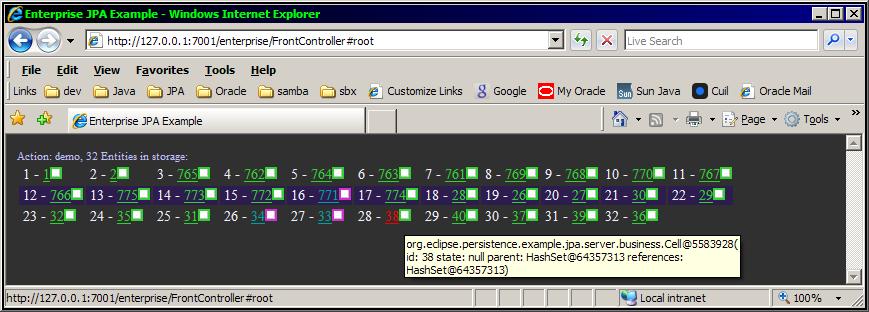
Two Persistence Units
This section details a use case where we need to use two different persistence units defined in the same persistence.xml file where the datasources are on different physical database servers.
The following capture is from a persistence.xml mapping file on the EJB.jar that has two persistence units where each point to the same Entity name "Cell" but the entities are in different packages. This will test any possible naming conflict between the entities.
persistence.xml with three persistence units
<persistence version="1.0" xmlns="http://java.sun.com/xml/ns/persistence" xmlns:xsi="http://www.w3.org/2001/XMLSchema-instance" xsi:schemaLocation="http://java.sun.com/xml/ns/persistence http://java.sun.com/xml/ns/persistence/persistence_1_0.xsd"> <persistence-unit name="exampleDuplicate" transaction-type="JTA"> <provider>org.eclipse.persistence.jpa.PersistenceProvider</provider> <jta-data-source>remoteJTA</jta-data-source> <class>org.eclipse.persistence.example.jpa.server.entity.Cell</class> <exclude-unlisted-classes>true</exclude-unlisted-classes> <properties> <property name="eclipselink.target-server" value="WebLogic_10"/> <property name="eclipselink.logging.level" value="FINEST"/> <!-- property name="eclipselink.orm.validate.schema" value="false"/--> </properties> </persistence-unit> <persistence-unit name="example" transaction-type="JTA"> <provider>org.eclipse.persistence.jpa.PersistenceProvider</provider> <jta-data-source>localJTA</jta-data-source> <class>org.eclipse.persistence.example.jpa.server.business.Cell</class> <exclude-unlisted-classes>true</exclude-unlisted-classes> <properties> <property name="eclipselink.target-server" value="WebLogic_10"/> <property name="eclipselink.logging.level" value="FINEST"/> <!-- property name="eclipselink.orm.validate.schema" value="false"/--> </properties> </persistence-unit> <persistence-unit name="exampleLocal" transaction-type="RESOURCE_LOCAL"> <provider>org.eclipse.persistence.jpa.PersistenceProvider</provider> <class>org.eclipse.persistence.example.jpa.server.business.Cell</class> <exclude-unlisted-classes>true</exclude-unlisted-classes> <properties> <property name="eclipselink.jdbc.driver" value="oracle.jdbc.driver.OracleDriver"/> <property name="eclipselink.jdbc.platform" value="org.eclipse.persistence.platform.database.oracle.OraclePlatform"/> <property name="eclipselink.jdbc.url" value="jdbc:oracle:thin:@127.0.0.1:1521:orcl"/> <property name="eclipselink.jdbc.user" value="scott"/> <property name="eclipselink.jdbc.password" value="pw"/> <!-- property name="eclipselink.logging.logger" value="JavaLogger"/--> <!-- turn on table generation only to initialize db and then disable the two elements below --> <!-- property name="eclipselink.ddl-generation" value="drop-and-create-tables"/> <property name="eclipselink.ddl-generation.output-mode" value="database"/--> </properties> </persistence-unit> </persistence>
In the case of using both persistence units I get 2 sets of 4 logs = 8 for the 4 connections to the 2 datasources The two datasources in my case are Oracle11g (remoteJTA) and Oracle10g (localJTA) - both using the same 11g driver - so it is easier to tell them apart in the logs.
EL Example: enterprise: Object: org.eclipse.persistence.example.jpa.server.entity.Cell@26145598( id: 1 state: null left: null right: null parent: HashSet@234560 references: HashSet@234560)
When i use the exampleDuplicate persistence unit i get a login for the first Oracle 10g based datasource (remoteJTA)
EL Config: 2008.12.15 15:43:56.419--ServerSession(3303389)--Connection(28810575)--Thread(Thread[)--Connected: jdbc:oracle:thin:@127.0.0.1:1521:orcl User: SCOTT Database: Oracle Version: Oracle Database 11g Enterprise Edition Release 11.1.0.6.0 - Production With the Partitioning, OLAP, Data Mining and Real Application Testing options Driver: Oracle JDBC driver Version: 11.1.0.7.0-Production EL Config: 2008.12.15 15:43:56.419--ServerSession(3303389)--Connection(28892307)--Thread(Thread[)--connecting(DatabaseLogin( platform=>Oracle10Platform user name=> "" connector=>JNDIConnector datasource name=>null ))
and the persist call for the first set of entities in the first persistence unit
EL Example: enterprise: ApplicationService persisting: org.eclipse.persistence.example.jpa.server.business.Cell@13251215( id: null state: null left: null right: null parent: HashSet@18981093 references: HashSet@18981093) on EM: org.eclipse.persistence.internal.jpa.EntityManagerImpl@1a7ed8f> later when I use the other example persistence unit i get a login for the second datasource
Later when using the Oracle 11g based datasource (localJTA)
EL Config: 2008.12.15 15:43:56.966--ServerSession(25279766)--Connection(6794127)--Thread(Thread[)--Connected: jdbc:oracle:thin:@10.156.53.19:1521:orcl User: SCOTT Database: Oracle Version: Oracle Database 10g Enterprise Edition Release 10.2.0.1.0 - Production With the Partitioning, OLAP and Data Mining options Driver: Oracle JDBC driver Version: 11.1.0.7.0-Production EL Config: 2008.12.15 15:43:56.966--ServerSession(25279766)--Connection(3176465)--Thread(Thread[)--connecting(DatabaseLogin( platform=>Oracle10Platform user name=> "" connector=>JNDIConnector datasource name=>null ))
And the persist call for the second set of entities in the second persistence unit
EL Example: enterprise: ApplicationService2 persisting: org.eclipse.persistence.example.jpa.server.entity.Cell@20979305( id: null state: null left: null right: null parent: HashSet@14247956 references: HashSet@14247956) on EM: org.eclipse.persistence.internal.jpa.EntityManagerImpl@14bf56d
The servlet client uses two stateless session beans for entitymanager access
public class FrontController extends HttpServlet implements Servlet { @EJB(beanName="ApplicationService") public ApplicationServiceLocal applicationService; @EJB(beanName="ApplicationService2") public ApplicationServiceLocal2 applicationService2; ... // Later I must fully reference my entities because in this case they have the same class name in different packages List<org.eclipse.persistence.example.jpa.server.business.Cell> rowsList = (List<org.eclipse.persistence.example.jpa.server.business.Cell>)getApplicationService().query("select object(e) from Cell e"); List<org.eclipse.persistence.example.jpa.server.entity.Cell> rowsList2 = (List<org.eclipse.persistence.example.jpa.server.entity.Cell>)getApplicationService2().query("select object(e) from Cell e");
Each entitymanager is injected into the stateless session beans
package org.eclipse.persistence.example.jpa.server.entity; @Local @Stateless public class ApplicationService implements ApplicationServiceLocal { @PersistenceContext(unitName="example", type=PersistenceContextType.TRANSACTION) private EntityManager entityManager;
package org.eclipse.persistence.example.jpa.server.entity; @Local @Stateless public class ApplicationService2 implements ApplicationServiceLocal2 { @PersistenceContext(unitName="exampleDuplicate", type=PersistenceContextType.TRANSACTION) private EntityManager entityManager;
Both versions of the Cell entity (in different packages but with the same schema on different databases) are located on the ejb.jar along with the session beans
package org.eclipse.persistence.example.jpa.server.entity; @Entity @Table(name="EL_CELL") public class Cell implements Serializable {
package org.eclipse.persistence.example.jpa.server.business; @Entity @Table(name="EL_CELL") public class Cell implements Serializable {
Troubleshooting
- 1) If you get a "domain locked" popup error in eclipse when publishing your ear - delete the following lock file in your server domain
- $WEBLOGIC_HOME\user_projects\domains\base_domain\edit.lok
- 2) If you get a WST error popup in Eclipse when you try to export your EAR - it is most likely due to an inconsistent workspace (a file is missing/modified on the disc but has not been refreshed to the Eclipse IDE) - try refreshing the 3 projects here first.
- 3) If you have changed your entity schema between deployments and you find some weird behavior where you are seeing both your new entities and the old entities (without the schema changes) - this is most likely due to a cached entity on the server that has not been updated for some reason - usually when you combine both manual deployment to the autodeploy directory and "run-on-server" from the Eclipse IDE.
- The workaround is to clear non-session entities from the cache under
- user_projects\domains\base_domain\servers\AdminServer\cache\EJBCompilerCache
Password Encryption Error
For application defined datasources, if you get the following invalid pad byte exception when deploying your EAR to WebLogic 10.3 then check that you are using the latest AES encryption instead of 3DES. You can regenerate your encrypted password by creating a temporary globally defined datasource and viewing the *jdbc.xml file generated on your domain config directory.
Feb 20, 2009 11:46:01 AM EST> <Error> <Deployer> <BEA-149265> <Failure occurred in the execution of deployment request with ID '1235148360979' for task '20'. Error is: 'com.rsa.jsafe.JSAFE_PaddingException: Could not perform unpadding: invalid pad byte.' com.rsa.jsafe.JSAFE_PaddingException: Could not perform unpadding: invalid pad byte. at com.rsa.jsafe.JA_PKCS5Padding.a(Unknown Source) at com.rsa.jsafe.JG_BlockCipher.decryptFinal(Unknown Source) at weblogic.security.internal.encryption.JSafeEncryptionServiceImpl.decryptBytes(JSafeEncryptionServiceImpl.java:113) at weblogic.security.internal.encryption.JSafeEncryptionServiceImpl.decryptString(JSafeEncryptionServiceImpl.java:173) at weblogic.security.internal.encryption.ClearOrEncryptedService.decrypt(ClearOrEncryptedService.java:96)
<password-encrypted>{AES}...=</password-encrypted>
EJB bean JNDI client lookup without injection
The following steps need to be done so that a non-servlet client (J2SE) can lookup an instance of the stateless session bean deployed on WebLogic by this application.
weblogic-ejb-jar.xml
TBD
JMX MBeans
- To view MBeans on WebLogic 10.3 use the following standard SUN JDK 1.6 Jconsole application - use these classpath and connection string settings.
- Set your path to the target JVM - here it should be either the bundled SUN JDK or the JRockit JVM.
- Launch JConsole
C:\>jconsole -J-Djava.class.path=C:/opt/wls1031_l16/jdk160_11/lib/jconsole.jar;C:/opt/wls1031_l16/jdk160_11/l ib/tools.jar;C:/opt/wls1031_l16/wlserver_10.3/server/lib/wljmxclient.jar -J-Djmx.remote.protocol.provider.pkgs=weblogic.management.remote -J-Dcom.sun.management.jmxremote
- You will see the following dialog - select the remote service section.
- Note: however this method of launching JConsole restricts you to the MBean tab, to view the other memory, threads, vm summary, classes tabs launch jconsole normally without parameters by selecting the weblogic.Server local process
service:jmx:rmi:///jndi/iiop://127.0.0.1:7001/weblogic.management.mbeanservers.runtime or service:jmx:t3://127.0.0.1:7001/jndi/weblogic.management.mbeanservers.runtime username/password = weblogic console username/password
- You will see the following TopLink/EclipseLink tree as well as other application specific management branches in the JConsole view
References
- See Integrating EclipseLink with an Application Server in the ELUG
- See Developing JPA Projects in the EclipseLink User's Guide.
- http://dev.eclipse.org/svnroot/rt/org.eclipse.persistence/trunk/examples/org.eclipse.persistence.example.jpa.server.weblogic.enterpriseEAR
- http://dev.eclipse.org/svnroot/rt/org.eclipse.persistence/trunk/examples/org.eclipse.persistence.example.jpa.server.weblogic.enterpriseEJB
- http://dev.eclipse.org/svnroot/rt/org.eclipse.persistence/trunk/examples/org.eclipse.persistence.example.jpa.server.weblogic.enterpriseWeb
- EclipseLink Architecture and UML Diagrams

